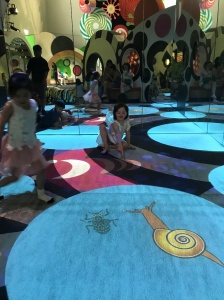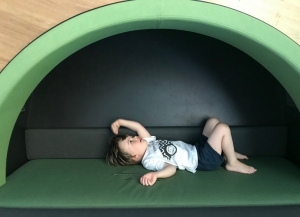Over the holidays I took my own two children to the Pauline Gandel Children’s Gallery at Melbourne Museum. It was a first-time visit and long overdue!

The space was joyful, playful and engaging – my pre-school aged children had an absolute ball. We didn’t even get to spend much time in the outdoor space, as it was particularly hot, but the indoor space kept them endlessly engaged. I spent the entire visit playing and exploring along with my children while simultaneously reflecting on the space from a professional perspective. Particularly around engaging young children and the importance of play.
This is clearly an example of a large project – but I think there are things to learn for small and large organisations alike. Some of the things I noticed particularly were:

Playfulness – the interactive spaces and activities had a obviously playfulness to them. They created delight and laughter. 20 children gleefully chasing projections of bugs across the ground was a good example.

Nooks – The space was full of child-friendly nooks – enticing cozy spaces and tunnels that drew children in. They encouraged reflection and discovery. The story pods that required kids to crawl in, lay down and look up were the ideal spot for the indigenous stories they shared.

Gross motor movement – Pre-schoolers need to move. The fact that this space encouraged climbing, jumping, stretching and more meant the space was full of really happy children. They could be themselves and they could extend themselves – they wanted to explore and discover things because they could use their body.

Learning without words – there were lots of spots where children could ‘do’. They could learn without a guide or panels. One example was the interactive butterfly art – children could decorate the butterflies and their creations were digitally mirrored to the other wing and then animated on the screen in front of them. They were learning about symmetry and movement without being ‘told’ a thing.
This is one example of many innovative spaces and programs museums, galleries, zoos, gardens (and more!) are creating for pre-school children. Sovereign Hill has also recently opened an exciting playspace for young children to literally climb all over some the things they can only look at elsewhere in the museum. For the young children that visit our museums, galleries and sites we can look to these concepts to inspire us to create opportunities for joyful active play and discovery. If we delight the youngest of our audiences they will want to return to explore our sites further as they grow.